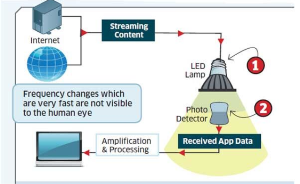 Li-Fi (Light Fidelity) is a bidirectional, high speed and fully networked wireless communication technology similar to Wi-Fi. Coined by Prof. Harald Haas, Li-Fi is a subset of optical wireless communications (OWC) and can be a complement to RF communication (Wi-Fi or Cellular network), or a replacement in contexts of data broadcasting. It is so far measured to be about 100 times faster than Wi-Fi, reaching speeds of 224 gigabits per second.
Li-Fi (Light Fidelity) is a bidirectional, high speed and fully networked wireless communication technology similar to Wi-Fi. Coined by Prof. Harald Haas, Li-Fi is a subset of optical wireless communications (OWC) and can be a complement to RF communication (Wi-Fi or Cellular network), or a replacement in contexts of data broadcasting. It is so far measured to be about 100 times faster than Wi-Fi, reaching speeds of 224 gigabits per second.
It is wireless and uses visible light communication or infra-red and near ultraviolet (instead of radio frequency waves) spectrum, part of optical wireless communications technology, which carries much more information, and has been proposed as a solution to the RF-bandwidth limitations. A complete solution includes an industry led standardization process.
Technology details
This OWC technology uses light from light-emitting diodes (LEDs) as a medium to deliver networked, mobile, high-speed communication in a similar manner to Wi-Fi.[4] The Li-Fi market is projected to have a compound annual growth rate of 82% from 2013 to 2018 and to be worth over $6 billion per year by 2018.
PureLiFi demonstrated the first commercially available Li-Fi system, the Li-1st, at the 2014 Mobile World Congress in Barcelona.